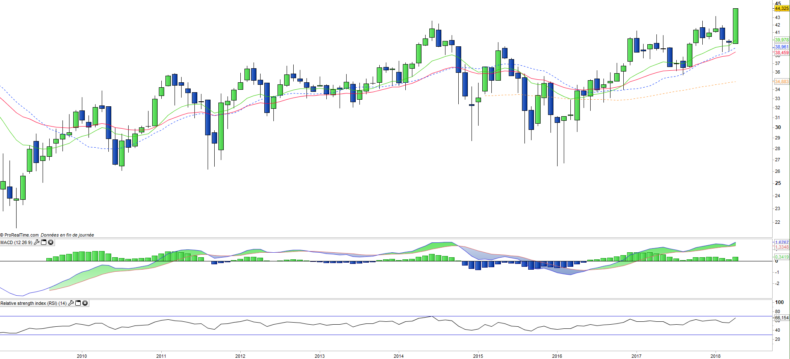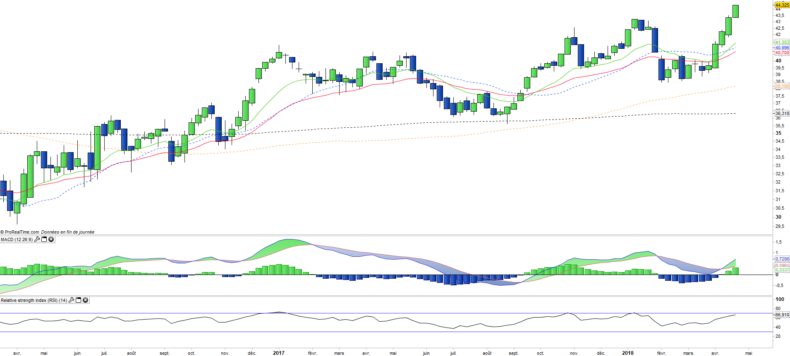Lyxor ETF OIL & GAS (OIL) - 27/04/2018
Short Term strategy: Positive (100%) / Trend +
Long Term strategy: Positive (100%) / Trend +
Characteristics of the ETF
The ETF OIL (Lyxor) replicates the Stoxx Europe 600 Oil & Gas Index, which is composed of the main European stocks in the sector. This index is quite concentrated since it has only 20 values. By geography, the index is mainly exposed to the Euro zone with a weighting of about 30% for France, 16% for the Netherlands and 11% for Italy while the UK weighs nearly 21%.
The ETF OIL bears a fee of 0.3% with AUM of approximately 395M €. The replication method is indirect (via a swap) and the dividend distribution policy is capitalized.
Alternative ETFs: EXH1 (iShares in Euro)
Latest developments
The OIL index has risen by + 8.2% since the beginning of the year, which is obviously linked to the rise in crude prices.
The WTI is on 2-year highs around $ 68, while the geopolitical premium is recovering with the crises in the Middle East, which oppose especially Iran and Saudi Arabia. The US should unilaterally denounce the nuclear deal on May 12, but negotiations remain possible on an "additional layer" of agreement on Iran's ballistic program. A wider crisis is also possible in the Middle East under the background of the resumption of the Iranian nuclear program.
In any case, the tensions and uncertainties should persist for some time, while the "investment gap" noted by the cessation of spending by majors since 2014 should ultimately weigh on supply, while the growth of shale oil production cannot be extrapolated due to bottlenecks and infrastructure problems, and while global demand is very strong.
Index & components
This oil & gas index is rather concentrated since it contains only 20 stocks that are essentially large market capitalizations, while the top 3 oil majors, which represent 60% of the index, weigh around € 100bn each. Total (30% of the index), Royal Dutch Shell-A (15.3%) and BP (15.3%).
The index also includes industrial stocks such as Neste Oil (refining), Technip (engineering) and Vestas (wind power).
These values are linked to oil prices, but sometimes in opposite directions (refining is all the more profitable as the price of oil is low and stable), renewable energies are attractive when oil is expensive, while services oil prices are directly correlated to the price of crude and present a risk of increased volatility in a period of uncertainty both in terms of demand and supply.
The current period is characterized by an abundance of supply coming from shale oil, said "unconventional" and which has already caused a significant drop in prices since 2014. Oil prices are being pulled out of their range because of the geopolitical premium associated with the Middle East crises and the "investment gap" that results from the natural erosion of well productivity in the absence of investment coupled with a strong demand dynamic . The costs of shale actors tend to drop, but bottlenecks could emerge at a certain level of production, so the short / medium term remains rather bullish. In the longer term, the electric car and the lower consumption of combustion engines should have a deflationary effect on crude prices.
Major oil majors are already investing heavily in oil & shale gas, as well as in renewable energies. They should therefore continue to optimize their asset portfolios in the coming years without significant risk, while oil services players are much more exposed.
Monthly data
The monthly chart shows a long-term bullish trend that is accelerating upwards. The white candlestick of April is powerful and breaks up the long-term resistance of 42 €. This is a sign of great strength, in an uncertain and chaotic market environment. The index should be more directional (upwards) in the coming weeks / months because of this bullish breakout that could however be retested in the coming weeks.
Weekly data
On the weekly chart, we can see an increasing upward momentum leading to new highs. Bullish impulses tend to come to bear on the EMA100, and are fairly well signaled by the crossings of the weekly MACD. The oscillators confirm the bullish sentiment without displaying a state of overbought, which argues for the continuity of the trend.
ETF Objective
OIL is a UCITS ETF listed in €, which seeks to replicate the STOXX Europe 600 Oil & Gas (Net Return) index (20 european companies)
Characteristics
| Inception date | 25/10/2006 |
| Expense ratio | 0,30% |
| Issuer | Lyxor |
| Benchmark | Stoxx 600 Oil & Gas Net Return |
| Ticker | OIL |
| ISIN | FR0010344960 |
| UCITS | Yes |
| EU-SD Status | Out of scope |
| Currency | € |
| Exchange | Euronext Paris |
| Assets Under Management | 396 M€ |
| Dividend | Capitalization |
| PEA (France) | Yes |
| SRD (France) | Yes |
| Number of Holdings | 20 |
| Risk | 4/5 |
Country Breakdown
| France | 30% |
| United Kingdom | 21% |
| Netherlands | 16% |
| Italy | 11% |
| Norway | 7% |
| Spain | 6% |
| Danemark | 3% |
| Others | 6% |
Sector Breakdown
| Energy | 93% |
| Industrials | 4% |
| Consumer discretionary | 3% |
Top Ten Holdings
| Total | 30% |
| Royal Dutch Shell | 15% |
| BP | 15% |
| ENI | 10% |
| Statoil | 6% |
| Repsol | 5% |
| Vestas Wind Systems | 3% |
| TechnipFMC | 3% |
| Galp Energia | 2% |
| OMV | 2% |


